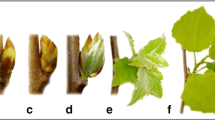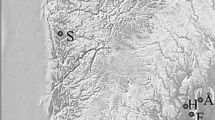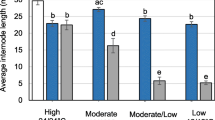Abstract
This study investigates whether the assumed increase of winter and spring temperatures is depicted by phenological models in correspondingly earlier bud burst (BB) dates. Some studies assume that rising temperatures lead to an earlier BB, but even later BB has been detected. The phenological model PIM (promoter-inhibitor-model) fitted to the extensive phenological database of the German Weather Service was driven by several climate scenarios. This model accounts for the complicated mechanistic interactions between chilling requirements, temperature and photo-period. It predicts BB with a r 2 between 0.41 and 0.62 and a RMSE of around 1 week, depending on species. Parameter sensitivities depict species dependent interactions between growth and chilling requirements as well as photo-period. A mean trend to earlier BB was revealed for the period 2002– 2100, varying between −0.05 and −0.11 days per year, depending on species. These trends are lower than for the period 1951– 2009. Within climate scenario period, trends are decreasing for beech and chestnut, stagnating for birch and increasing for oak. Results suggest that not fulfilled chilling requirements accompanied by an increasing dependency on photo-period potentially limit future BB advancement. The combination of a powerful phenological model, a large scale phenological database and several climate scenarios, offers new insights into the mechanistic comprehension of spring phenology.










Similar content being viewed by others
References
Ardia D, Boudt K, Carl P, Mullen KM, Peterson BG (2011) Differential evolution with DEoptim: an application to non-convex portfolio optimization. R J 3(1):27–34
Basler D (2016) Evaluating phenological models for the prediction of leaf-out dates in six temperate tree species across central europe. Agric For Meteorol 217(1):10–21
Basler D, Körner C (2012) Photoperiod sensitivity of bud burst in 14 temperate forest tree species. Agric For Meteorol 165(1):73–81
Basler D, Körner C (2014) Photoperiod and temperature responses of bud swelling and bud burst in four temperate forest tree species. Tree Physiol 34(4):377–388
Bonhomme R (2000) Bases and limits to using ’degree.day’ units. Eur J Agron 13(1):1–10
Caffarra A, Donnelly A, Chuine I (2011) Modelling the timing of Betula pubescens budburst. II. Integrating complex effects of photoperiod into process-based models. Clim Res 46(2):159–170
Chuine I, Morin X, Bugmann H (2010) Warming, photoperiods, and tree phenology. Science 329(5989):277–278
Dierenbach J, Badeck FW, Schaber J (2013) The plant phenological online database (PPODB): an online database for long-term phenological data. Int J Biometeorol 57(5):1–8
Doktor D (2008) Using satellite imagery and ground observations to quantify the effect of intra-annually changing temperature patterns on spring time phenology. PhD thesis, University of London
Enke W, Kreienkamp F (2006) WETTREG A1B SCENARIO RUN, UBA PROJECT. Tech. rep., World Data Center for Climate, 10-year slices, e.g. CERA-DB ”WR_A1B_2071_2080”. http://cera-www.dkrz.de/WDCC/ui/Compact.jsp?acronym=WR_A1B_2071_2080; Additionally, Scenarios A2 and B1 as well as wet and dry realisations were used.
European Environment Agency (2012) Climate change, impacts and vulnerability in Europe 2012. ISBN: 978-92-9213-346-7
Fu Y, Campioli M, Van Oijen M, Deckmyn G, Janssens I (2012) Bayesian comparison of six different temperature-based budburst models for four temperate tree species. Ecol Mod 230(1):92–100
Fu Y, Piao S, Zhao H, Jeong SJ, Wang X, Vitasse Y, Ciais P, Janssens I (2014) Unexpected role of winter precipitation in determining heat requirement for spring vegetation green-up at northern middle and high latitudes. Glob Chang Biol 20(12):3743–3755
Fu Y, Piao S, Vitasse Y, Zhao H, De Boeck H, Liu Q, Yang H, Weber U, Hnninen H, Janssens I (2015a) Increased heat requirement for leaf flushing in temperate woody species over 19802012: effects of chilling, precipitation and insolation. Global Chang Biol 21(7):2687–2697
Fu Y, Zhao H, Piao S, Peaucelle M, Peng S, Zhou G, Ciais P, Huang M, Menzel A, Penuelas J, Song Y, Vitasse Y, Zeng Z, Janssens I (2015b) Declining global warming effects on the phenology of spring leaf unfolding. Nature 526(1):104–107
Hänninen H, Kramer K (2007) A framework for modelling the annual cycle of trees in boreal and temperate regions. Silva Fennica 41(1):167–205
Hänninen H, Tanino K (2011) Tree seasonality in a warming climate. Trends Plant Sci 16(8):412–416
Heide OM (1993) Daylength and thermal time responses of budburst during dormancy release in some northern deciduous trees. Physiol Plant 88(4):531–540
IPCC (2014) Climate change 2014: impacts, adaptation, and vulnerability. In: Field CB, Barros VR, Dokken DJ, Mach KJ, Mastrandrea MD, Bilir TE, Chatterjee M, Ebi KL, Estrada YO, Genova RC, Girma B, Kissel ES, Levy AN, MacCracken S, Mastrandrea PR, White LL (eds) Part A: global and sectoral aspects. contribution of working group II to the fifth assessment report of the intergovernmental panel on climate change. Cambridge University Press, Cambridge, p 1132
Jacob D, Mahrenholz P (2006) REMO A1B SCENARIO RUN, UBA PROJECT, DATASTREAM 3. Tech. rep., World Data Center for Climate, cERA-DB ”REMO_UBA_A1B_D3”. http://cera-www.dkrz.de/WDCC/ui/Compact.jsp?acronym=REMO_UBA_A1B_D3; Additionally, Scenarios A2 and B1 were used
Jacob D, Elizalde A, Kotova L, Pfeifer S, Moseley C, Kumar P, Rechid D, Teichmann C (2006) Regional climate modelling. http://www.remo-rcm.de, last accessed on 2013-01-08
Johnson I, Thornley JHM (1985) Temperature dependence of plant and crop processes. Ann Bot 55(1):1–24
Keenan T (2015) Phenology: spring greening in a warming world. Nature 526(7571):48–49
Kramer K, Friend A, Leinonen I (1996) Modelling comparison to evaluate the importance of phenology and spring frost damage for the effects of climate change on growth of mixed temperate-zone deciduous forests. Clim Res 7(1):31–41
Kunstmann H, Schneider K, Forkel R, Knoche R (2004) Impact analysis of climate change for an Alpine catchment using high resolution dynamic downscaling of ECHAM4 time slices. Hydrol Earth Syst Sci 8(6):1030–1044
Lange M (2013) phenmod: auxiliary functions for phenological data processing, modelling and result handling. R package version 1.2-2. http://CRAN.R-project.org/package=phenmod, Last accessed on 2013-08-20
Laube J, Sparks T, Estrella N, Höfler J, Ankerst D, Menzel A (2014) Chilling outweighs photoperiod in preventing precocious spring development. Glob Chang Biol 20(1):170–182
Linkosalo T, Carter TR, Hakkinen R, Hari P (2000) Predicting spring phenology and frost damage risk of Betula spp. under climatic warming: a comparison of two models. Tree Physiol 20(17):1175–1182
Linkosalo T, Hakkinen R, Hanninen H (2006) Models of the spring phenology of boreal and temperate trees: is there something missing? Tree Physiol 26(9):1165–1172
Meynen E, Schmithüsen J (1962) Handbuch der naturräumlichen Gliederung Deutschlands. Selbstverlag der Bundesanstalt fr Landeskunde, Bad Godesberg
Migliavacca M, Sonnentag O, Keenan TF, Cescatti A, O’ Keefe J, Richardson AD (2012) On the uncertainty of phenological responses to climate change, and implications for a terrestrial biosphere model. Biogeosciences 9(1):2063–2083
Morin X, Lechowicz MJ, Augspurger C, O’ Keefe J, Viner D, Chuine I (2009) Leaf phenology in 22 North American tree species during the 21st century. Global Chang Biol 15(4):961–975
Moser L, Fonti P, Buentgen U, Esper J, Luterbacher J, Franzen J, Frank D (2010) Timing and duration of European larch growing season along altitudinal gradients in the Swiss Alps. Tree Physiol 30(2):225–233
Myking T, Heide OM (1995) Dormancy release and chilling requirement of buds of latitudinal ecotypes of betula pendula and b. pubescens. Tree Physiol 15(11):697–704
Nakicenovic N, Alcamo J, Davis D, de Vries B, Fenhann J, Gaffin S, Gregory K, Grubler A, Jung TY, Kram T, Lebre La Rovere E, Michaelis L, Mori S, Morita T, Pepper W, Pitcher H, Price L, Riahi K, Roehrl A, Rogner H, Sankovski A, Schlesinger M, Shukla P, Smith S, Swart R, van Rooijen S, Victor N, Dadi Z (2000) Special report on emissions scenarios. Cambridge University Press
Olsson C, Jönsson A (2014) Process-based models not always better than empirical models for simulating budburst of Norway spruce and birch in europe. Glob Chang Biol 20(11):3492–3507
Parmesan C (2007) Influences of species, latitudes and methodologies on estimates of phenological response to global warming. Global Chang Biol 13(1):1860–1872
Peñuelas J, Rutishauser T, Filella I (2009) Phenology feedbacks on climate change. Science 324:887–888
Peñuelas J, Sardans J, Estiarte M, Ogaya R, Carnicer J, Coll M, Barbeta A, Rivas-Ubach A, Llusia J, Garbulsky M, Filella I, Jump A (2013) Evidence of current impact of climate change on life: a walk from genes to the biosphere. Global Chang Biol 19(8):2303–2338
Pearson K (1920) Notes on the history of correlation. Biometrika 13(1):25–45
Pope K, Dose V, Da Silva D, Brown P, Leslie C, Dejong T (2013) Detecting nonlinear response of spring phenology to climate change by Bayesian analysis. Global Chang Biol 19(5):1518–1525
R Development Core Team (2009) R: a language and environment for statistical computing. R Foundation for Statistical Computing, Vienna. http://www.R-project.org, ISBN 3-900051-07-0
Saxe H, Cannell M, Johnsen B, Ryan M, Vourlitis G (2001) Tree and forest functioning in response to global warming. New Phytol 149(3):369–399
Schaber J (2012) pheno: auxiliary functions for phenological data analysis. R package version 1.6. http://CRAN.R-project.org/package=pheno, Last accessed on 2013-01-09
Schaber J, Badeck FW (2002) Evaluation of methods for the combination of phenological time series and outlier detection. Tree Physiol 22:973–982
Schaber J, Badeck FW (2003) Physiology-based phenology models for forest tree species in germany. Int J Biometeorol 47:193–201
Schaber J, Badeck FW (2005) Plant phenology in germany over the 20th century. Reg Environ Chang 5:37–46
Schnelle F (1955) Pflanzen-Phänologie, 1st. Probleme der Bioklimatologie, Akademische Verlagsgesellschaft Geest & Portig K.-G, Leipzig
Sherry R, Zhou X, Gu S, Arnone J, Schimel D, Verburg P, Wallace L, Luo Y (2007) Divergence of reproductive phenology under climate warming. Proc Natl Acad Sci USA 104(1):198–202
Singer MC, Parmesan C (2010) Phenological asynchrony between herbivorous insects and their hosts: signal of climate change or pre-existing adaptive strategy? Phil Trans R Soc B-Biol Sci 365(1555):3161–3176
Spekat A, Enke W, Kreienkamp F (2007) Neuentwicklung von regional hoch aufgelösten Wetterlagen für Deutschland und Bereitstellung regionaler Klimaszenarios auf der Basis von globalen Klimasimulationen mit dem Regionalisierungsmodell WETTREG auf der Basis von globalen Klimasimulationen mit ECHAM5/MPI-OM T63L31 2010 bis 2100 für die SRES-Szenarios B1, A1B und A2. Endbericht, Umweltbundesamt, Förderkennzeichen 204 41 138
Thackeray SJ, Sparks TH, Frederiksen M, Burthe S, Bacon PJ, Bell JR, Botham MS, Brereton TM, Bright PW, Carvalho L, Clutton-Brock T, Dawson A, Edwards M, Elliott JM, Harrington R, Johns D, Jones ID, Jones JT, Leech DI, Roy DB, Scott WA, Smith M, Smithers RJ, Winfield IJ, Wanless S (2010a) Trophic level asynchrony in rates of phenological change for marine, freshwater and terrestrial environments. Glob Chang Biol 16(12):3304–3313
Thackeray SJ, Sparks TH, Frederiksen M et al (2010b) Trophic level asynchrony in rates of phenological change for marine, freshwater and terrestrial environments. Glob Chang Biol 16(12):3304–3313. doi:10.1111/j.1365-2486.2010.02165.x
Vitasse Y, François C, Delpierre N, Dufrêne E, Kremer A, Chuine I, Delzon S (2011) Assessing the effects of climate change on the phenology of European temperate trees. Agric For Meteorol 151(7):969–980
Wareing PF (1956) Photoperiodism in woody plants. Annu Rev Plant Physiol 7:191–214
Wareing PF, Saunders PF (1971) Hormones and dormancy. Annu Rev Plant Physiol 22:261–288
Acknowledgments
The authors wish to thank the administrators of the UFZ high performance computing system, especially Ben Langenberg and Christian Krause, for their support regarding scientific computation at the UFZ in Leipzig. We would like to thank the German Weather Service (DWD) for the online provision of meteorological observations via WebWerdis and the Deutsches Klimarechenzentrum GmbH (DKRZ) for providing regional climate simulation data via the CERA database. This work was supported by the Federal Ministry for Economic Affairs and Energy Germany (grant number 50EE1218).
Author information
Authors and Affiliations
Corresponding author
Appendices
Appendix A: Selected promoter-inhibitor-models
The best model for each selected species was chosen, therefore four models were used. For species birch (B. pendula), model number two with a 1 = 0 and no photo-period dependence for the forcing term of promoter and the breakdown term of inhibitor was used:
For species chestnut, model number eight with a 1 = 0 and no photo-period dependence for the forcing term of promoter was used:
For species beech, model number eleven with a 1 = 0 was used:
For species oak, model number twelve with a 4 = 0 was used:
Appendix B: DEoptim parameter settings
The optimization with DEoptim was done with following parameters:
-
population size N P = 400
-
iteration number I t = 100
-
crossover rate C R = 0.9
These parameters determine the fits’ convergence behaviour. The parameter bounds were set to following values:
-
−24∘ to 32∘ Celsius for temperature thresholds
-
0 to 1 for scaling parameters a i
Rights and permissions
About this article
Cite this article
Lange, M., Schaber, J., Marx, A. et al. Simulation of forest tree species’ bud burst dates for different climate scenarios: chilling requirements and photo-period may limit bud burst advancement. Int J Biometeorol 60, 1711–1726 (2016). https://doi.org/10.1007/s00484-016-1161-8
Received:
Revised:
Accepted:
Published:
Issue Date:
DOI: https://doi.org/10.1007/s00484-016-1161-8




